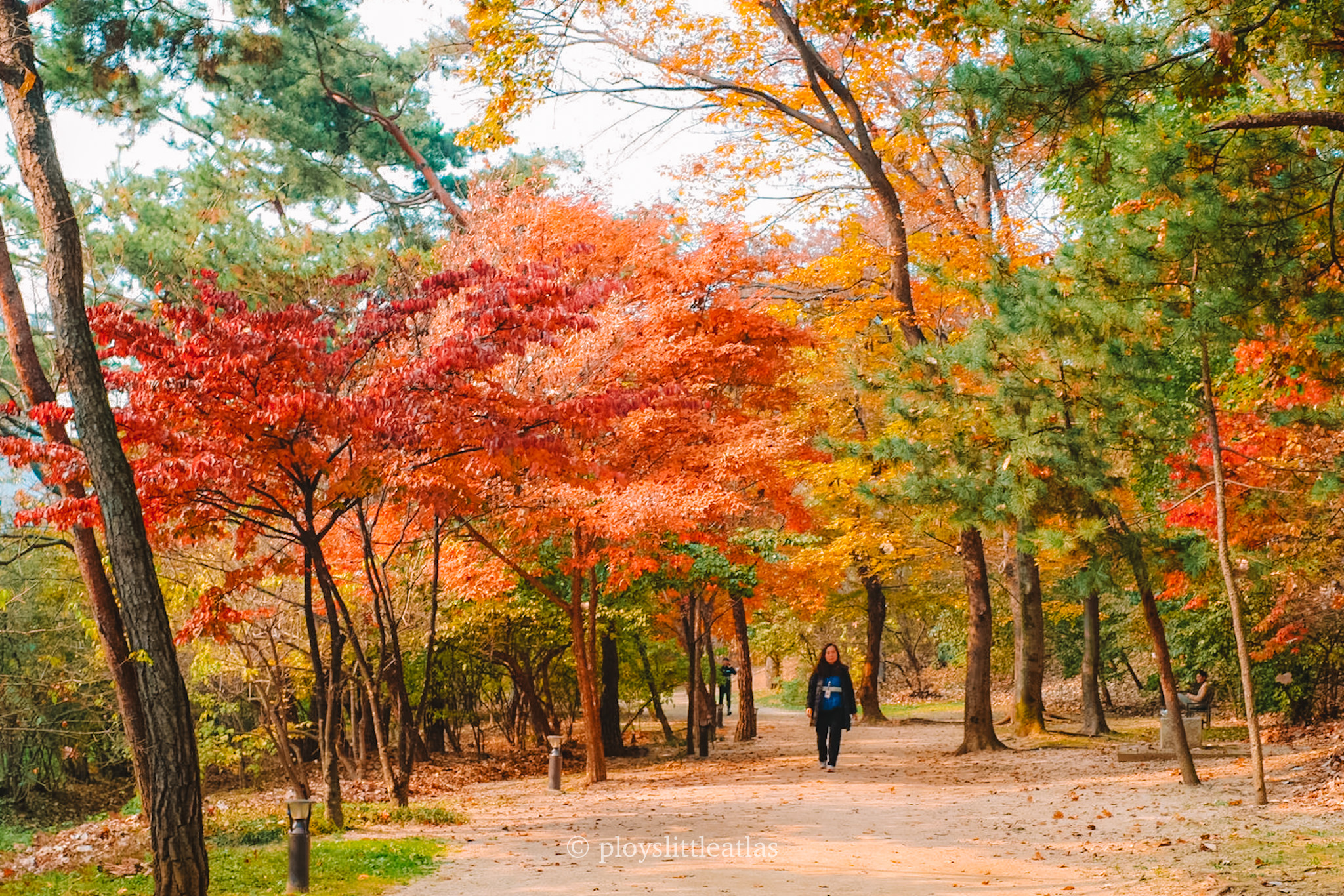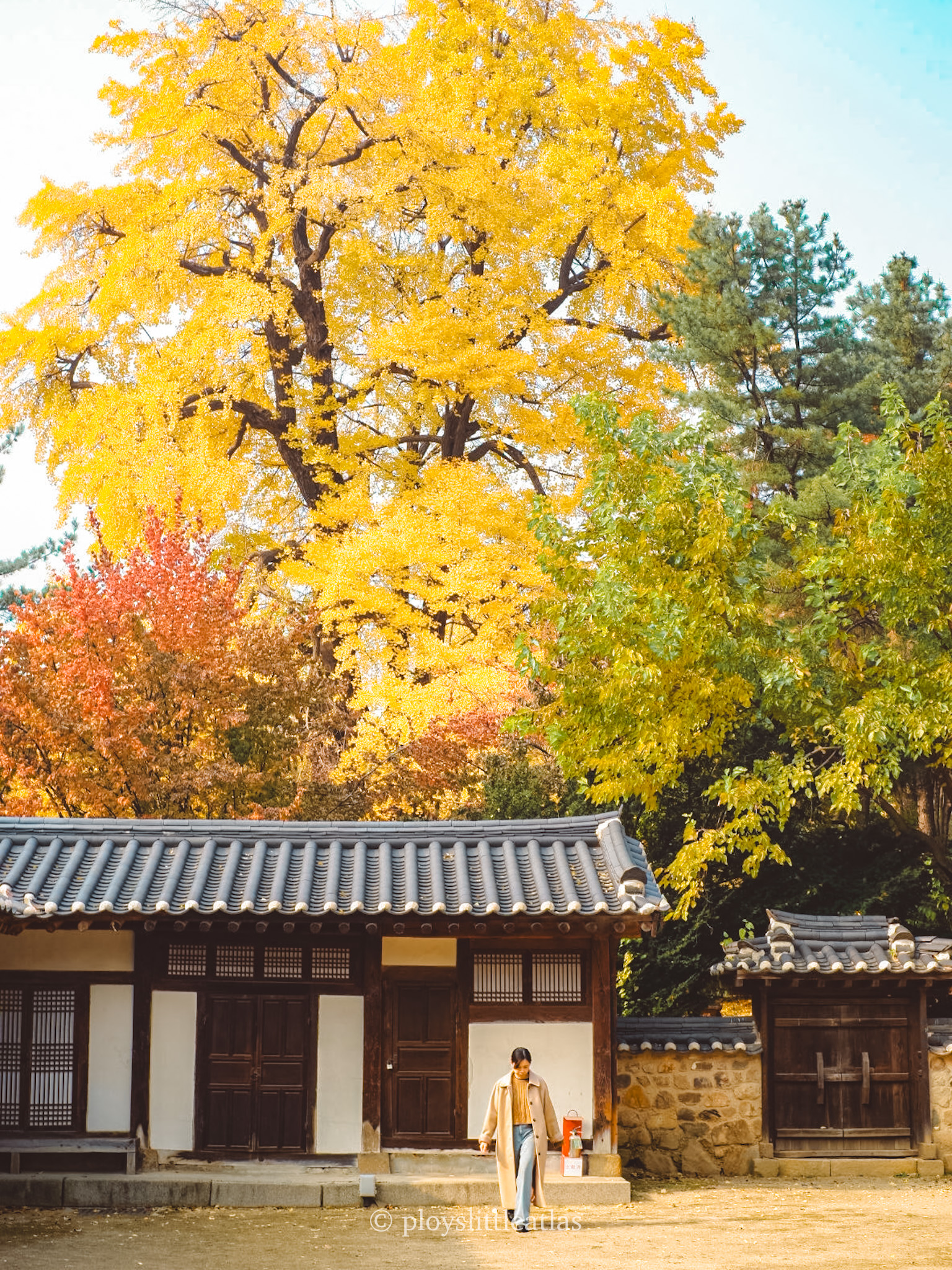After a prolonged procrastination, I finally checked out Seonjeongneung in Gangnam, and I’m so glad my visit fell on the peak of the autumn season. The scene was a breathtaking explosion of fall color, so magnificent it left me wondering why I hadn’t visited sooner. This unforgettable experience instantly earned Seonjeongneung a top spot on my list of must-visit places for fall foliage sightseeing in Seoul.
If you’re looking for a serene, historically rich, and visually stunning autumn escape in the heart of the city, look no further. Here’s your ultimate guide to witnessing the magic of Seonjeongneung in autumn.
About Seonjeongneung (선정릉)
Seonjeongneung is a UNESCO World Heritage Site that encompasses two royal tombs from the Joseon Dynasty: Seolleung (the tomb of King Seongjong) and Jeongneung (the tomb of King Jungjong). This sacred, park-like oasis in the middle of bustling Gangnam is more than just a historical landmark; it’s a peaceful retreat where history and nature coexist beautifully. Walking along its paths, you’re treading the same ground as kings and queens, surrounded by ancient trees and tranquil energy.
Autumn Spots to Capture Fall Foliage at Seonjeongneung
While the entire grounds are beautiful, a few spots are particularly photogenic during autumn.
The Trail to the History and Culture Center:
As you enter the main gate, take the left path from the ticket office. This small dirt road is your gateway into an autumn wonderland. Lined with myriad deciduous trees, it offers a stunning tunnel of fiery reds, vibrant oranges, and golden yellows that set the tone for your visit.

Seonjeongneung Royal Tombs Imperial House (선정릉재실):
About halfway to the Seongjong Royal Tomb, you’ll find a beautiful traditional Hanok house. While the architecture is intricate, the real showstopper is the 500-year-old ginkgo tree standing majestically beside it. The sheer canopy of brilliant, golden leaves is a heart-melting sight you won’t soon forget.

Seolleung Seongjong Royal Tomb (선릉성종왕릉):
This area is a playground for photographers. A big cluster of maple trees creates a stunning frame of deep red leaves. Aim your camera lens through these fiery branches towards the royal tomb annex or the nearby Hanok hall, and you’ll capture a picture so gorgeous it’s hard to believe you’re in the heart of busy Gangnam.

Feel free to wander beyond these highlights—every corner of this prestigious site holds its own autumnal charm.
When Is the Best Time to Visit?
Timing makes all the difference. From my experience, the deciduous clusters inside Seonjeongneung reach their peak color later than many other foliage spots in Seoul. If you’re hoping to catch the breathtaking golden and red scenery highlighted here, plan your visit for mid-November. I went on November 21st, and the trees were nothing short of spectacular.

Pro Tips for a Perfect Visit
To make your autumn trip to Seonjeongneung seamless and enjoyable, keep these tips in mind:
Check the Weather and Layer Up: Autumn weather in Seoul can be unpredictable. A crisp, sunny morning can turn into a chilly afternoon. Dress in layers so you can comfortably enjoy your stroll.
Go on a Weekday: This site is a popular spot for locals and tourists alike. To enjoy the tranquility and get those perfect, crowd-free photos, try to visit on a weekday.
Don’t Forget Your Camera (and a Wide Lens): The landscapes are vast, and the ginkgo tree is towering. A wide-angle lens will help you capture the full grandeur of the scenes.
Combine Culture and Relaxation: Bring a small mat or use one of the benches to simply sit and absorb the atmosphere. It’s a perfect place for a moment of reflection.
Wear Comfortable Shoes: The paths are well-maintained but are a mix of dirt, gravel, and pavement. Comfortable walking shoes are a must.
Respect the Site: Remember, this is a royal resting place. Be respectful by staying on the designated paths, not climbing on structures, and keeping noise to a minimum.
Additional Information
Hours of Operation:
- March – October: Daily 06:00 – 21:00
- November – January: Daily 06:00 – 17:30
- February: 06:00 – 18:00
- Holidays: Closed on Mondays
Entrance Fee:
- Individual: Adults (19 – 64) – KRW 1,000
- Group (more than 10 people): Adults (19 – 64) – KRW 800
How to Get There
Located in the heart of Gangnam, Seonjeongneung is incredibly easy to reach by public transportation. The subway is your best bet, and you have two convenient station options.
Recommended Route:
- Subway Line 2 (Green Line) or Suin-Bundang Line (Yellow Line)
- Get off at Seolleung Station (선릉역).
- Take Exit 10.
- From Exit 10, it’s an easy and pleasant 5–7 minute walk (about 444 meters). Head straight, passing Gangnam Finance Plaza, then turn left. You’ll find the entrance to Seonjeongneung at the end of the road.
Alternative Route:
- Subway Line 9 (Gold Line) or Suin-Bundang Line (Yellow Line)
- Get off at Seonjeongneung Station (선정릉역).
- Take Exit 3.
- This route is a slightly longer 10-15 minute walk (approx. 1,000 meters). After exiting, you’ll walk straight along the main road until you see the entrance on your left.
Why we recommend Seolleung Station Exit 10: It’s the closest and most direct route, making it the easiest choice, especially if it’s your first time visiting.
For a visual guide, it’s always a good idea to check Naver Maps or KakaoMap once you’re in Seoul for real-time, pinpoint directions.

If you’re curating your perfect Seoul autumn itinerary, look no further. Seonjeongneung delivers a powerful combination of profound history and breathtaking natural beauty that is unmatched. Don’t just take my word for it—see it for yourself. Grab your camera, check the peak foliage forecast, and make your way to this urban oasis. Your perfect autumn frame, backed by centuries of history, is waiting for you.
Access Map
Did this entry help you? Or Did you enjoy my photos? Help support my small blog by giving a little cup of joe. I am always grateful when readers reach out wanting to support 🙂
p.s. This post is independently created. However, when you book or purchase something through the retail links, I may earn an affiliate commission to help keep Ploy’s Little Atlas running. Thank you very much for your support!
p.p.s All images used (unless specified) are owned by the author of the blog and permission is required for a repost. Please, reach out via social media channels to ask beforehand if you’d like to use them.
